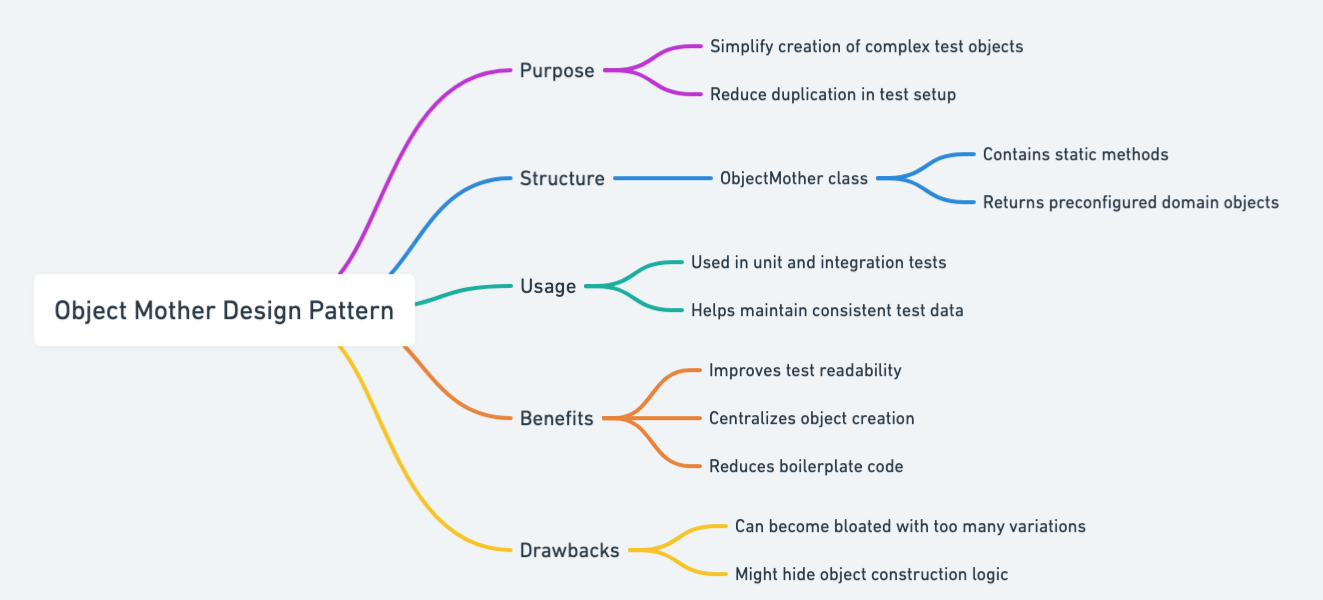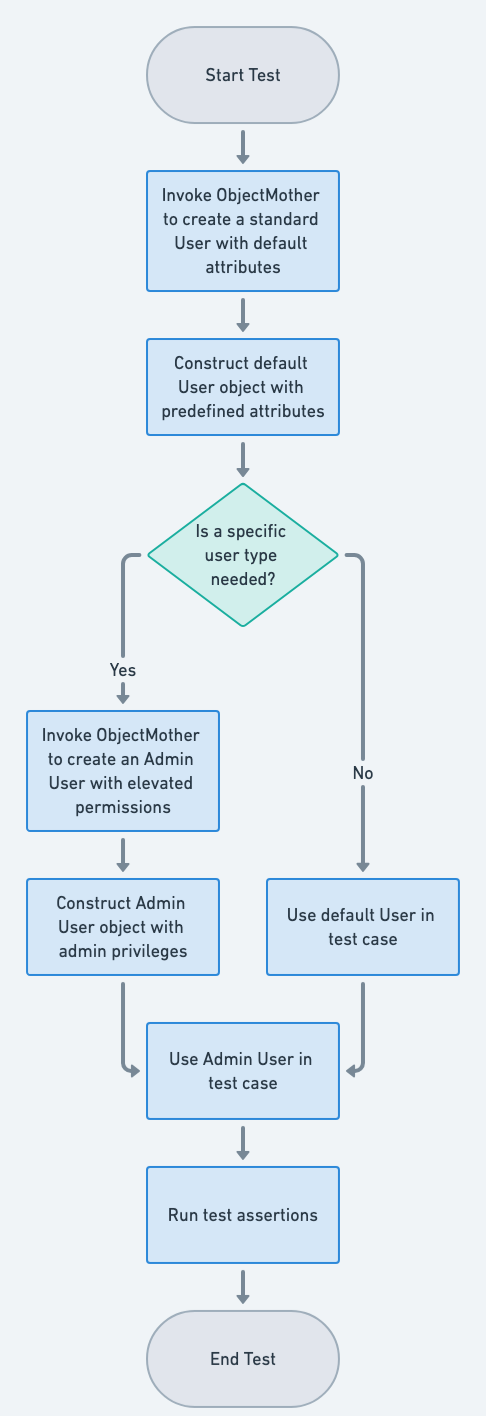Object Mother Pattern in Java: Simplifying Object Creation for Testing
Also known as
- Object Builder
- Test Data Builder
Intent of Object Mother Design Pattern
The Object Mother pattern simplifies the creation of objects for testing purposes in Java, ensuring that test cases are clear and maintainable by centralizing the logic needed to instantiate objects in a consistent state.
Detailed Explanation of Object Mother Pattern with Real-World Examples
Real-world example
Imagine you're developing a Java application for a travel agency. In your system, there are different types of travelers, such as tourists, business travelers, and travel agents, each with specific attributes and behaviors. To perform thorough testing, you need to create and manipulate these traveler objects in various contexts. The Object Mother Pattern can help you generate consistent and predefined traveler objects for testing purposes, ensuring that your tests are based on known, reliable data.
In plain words
The Object Mother Pattern is a design pattern used in Java to simplify the creation of objects with specific configurations, especially for testing. Instead of manually constructing objects with varying properties for each test case, you create a dedicated "Object Mother" class or method that produces these objects with predefined settings. This ensures that you have consistent and predictable test data, making your tests more reliable and easier to manage.
wiki.c2.com says
Object Mother starts with the factory pattern, by delivering prefabricated test-ready objects via a simple method call. It moves beyond the realm of the factory by
- facilitating the customization of created objects,
- providing methods to update the objects during the tests, and
- if necessary, deleting the object from the database at the completion of the test.
Mind map

Flowchart

Programmatic Example of Object Mother Pattern in Java
The Object Mother is a design pattern that aims to provide an easy way to create objects for testing purposes. It encapsulates the logic for building instances of complex objects in one place, making it easier to maintain and reuse across multiple tests.
First, we have the King class. This class represents a king with certain behaviors and states. The king can be drunk or sober, happy or unhappy. The king can also flirt with a queen, which may affect his happiness.
public class King implements Royalty {
boolean isDrunk = false;
boolean isHappy = false;
@Override
public void makeDrunk() {
isDrunk = true;
}
@Override
public void makeSober() {
isDrunk = false;
}
@Override
public void makeHappy() {
isHappy = true;
}
@Override
public void makeUnhappy() {
isHappy = false;
}
public boolean isHappy() {
return isHappy;
}
public void flirt(Queen queen) {
var flirtStatus = queen.getFlirted(this);
if (!flirtStatus) {
this.makeUnhappy();
} else {
this.makeHappy();
}
}
}The RoyaltyObjectMother class is where the Object Mother pattern is implemented. This class provides static methods to create different types of King and Queen objects. These methods encapsulate the logic for creating these objects, making it easier to create them in a consistent way across multiple tests.
class RoyaltyObjectMother {
static King createDrunkKing() {
var king = new King();
king.makeDrunk();
return king;
}
static King createHappyKing() {
var king = new King();
king.makeHappy();
return king;
}
// Other methods to create different types of King and Queen objects...
}In the RoyaltyObjectMotherTest class, we can see how the Object Mother pattern is used to create objects for testing. The RoyaltyObjectMother class is used to create King and Queen objects in different states, which are then used in the tests.
class RoyaltyObjectMotherTest {
@Test
void unsuccessfulKingFlirt() {
var soberUnhappyKing = RoyaltyObjectMother.createSoberUnhappyKing();
var flirtyQueen = RoyaltyObjectMother.createFlirtyQueen();
soberUnhappyKing.flirt(flirtyQueen);
assertFalse(soberUnhappyKing.isHappy());
}
// Other tests...
}In this way, the Object Mother pattern simplifies the creation of objects for testing, making the tests easier to read and maintain.
When to Use the Object Mother Pattern in Java
Use the Object Mother pattern when
- Creating complex objects with numerous fields for unit tests.
- You need to reuse a standard set of objects across multiple tests.
- Test setup is becoming cumbersome and repetitive.
Object Mother Pattern Java Tutorials
- What is an ObjectMother? (Stack Overflow)
- Object Mother (c2wiki)
- Test Data Builders: an alternative to the Object Mother pattern (Nat Pryce)
Real-World Applications of Object Mother Pattern in Java
- In unit testing frameworks to create test fixtures.
- In enterprise applications to generate standard domain objects required across multiple test cases.
- In open-source projects like Apache Commons and Spring Framework for test object creation.
Benefits and Trade-offs of Object Mother Pattern
Benefits:
- Code Simplification: Reduces boilerplate code in tests, making tests more readable and easier to maintain.
- Isolation: Ensures test data setup is isolated from test logic, enhancing clarity.
- Consistency: Provides a consistent way to create objects, reducing the likelihood of errors in test setup.
Trade-offs:
- Maintenance: Requires maintaining the Object Mother class itself, which can grow complex over time.
- Overhead: May introduce additional layers of abstraction that could complicate understanding for new developers.
Related Java Design Patterns
- Builder: Both patterns deal with object creation. The Object Mother is often simpler and used specifically in a testing context, whereas the Builder Pattern is more general-purpose.
- Factory Method: Similar in the sense of centralizing object creation logic. The Object Mother is specifically aimed at tests, while Factory Method is used more broadly in application code.